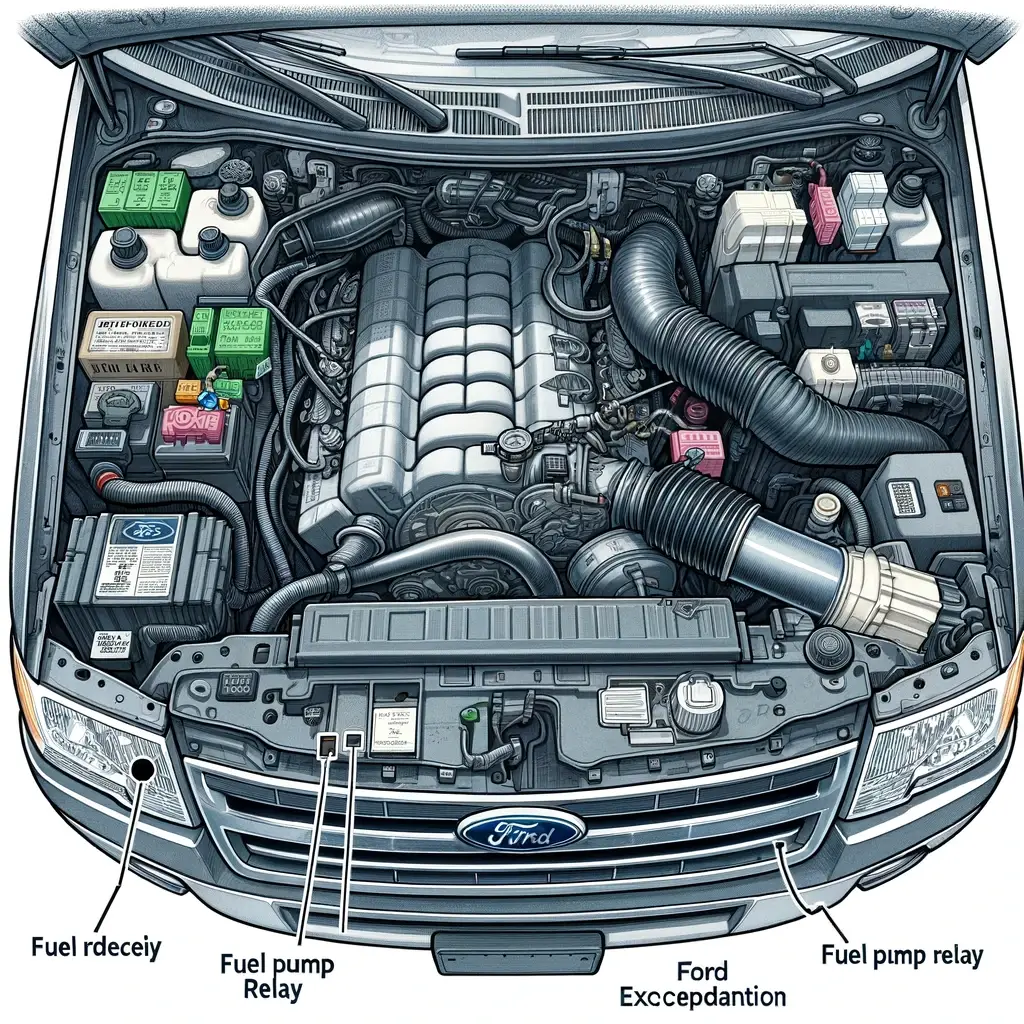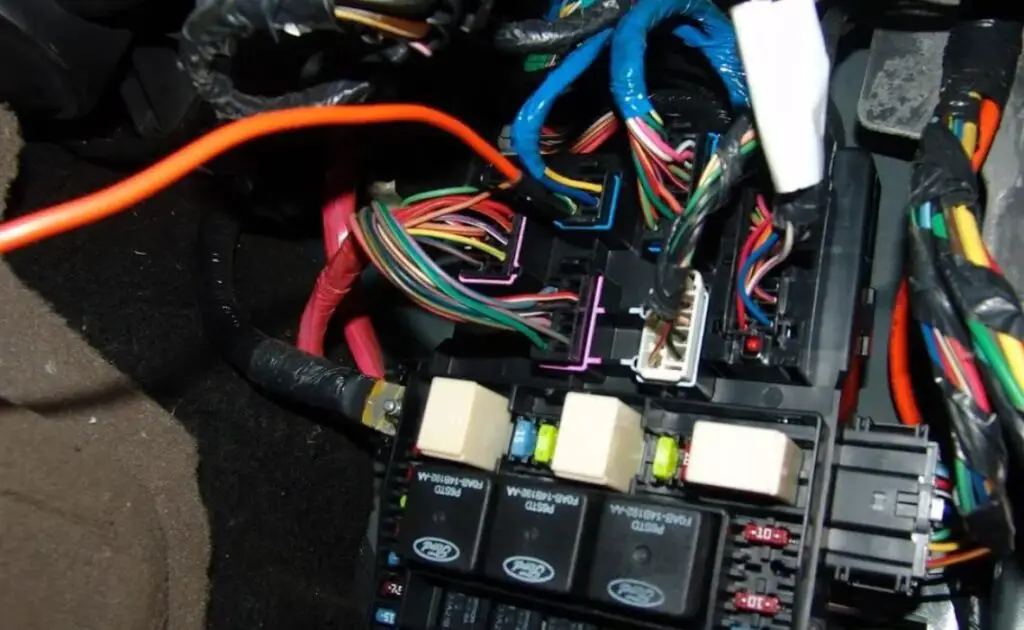The Ford Expedition’s fuel pump relay is a crucial component in the vehicle’s fuel system, playing an essential role in ensuring the proper flow of fuel from the tank to the engine. This guide provides detailed information about the location, identification, and importance of the fuel pump relay in various models of the Ford Expedition, as well as tips for troubleshooting and replacement.
As a proud Ford Expedition driver, I’m intimately familiar with the robustness of this vehicle and its myriad components that make it such a reliable ride. One small yet crucial component that ensures the heart of the vehicle (the engine) gets its necessary sustenance (fuel) is the fuel pump relay.
Understanding its location and significance can be pivotal, especially when troubleshooting potential fuel delivery issues.

Understanding the Fuel Pump Relay
- Role: The fuel pump relay acts as an electronic switch. When you turn the ignition key, the relay activates, allowing power to reach the fuel pump, which in turn pumps fuel from the tank to the engine.
- Significance: A malfunctioning fuel pump relay can lead to issues with starting the vehicle or keeping it running, as the engine may not receive the necessary fuel.
Read More: Ford 5.4 Coolant Temp Sensor Location
Ford Expedition Fuel Pump Relay Location
The location of the fuel pump relay in a Ford Expedition can vary depending on the year and model of the vehicle. Generally, it can be found in one of two places:
- Power Distribution Box Under the Hood:
- For many Ford Expedition models, the fuel pump relay is located in the power distribution box under the hood. This box is typically situated on the driver’s side.
- The relay itself is a small, rectangular component, often marked with a diagram or label on the box’s lid for identification.
- Inside the Vehicle:
- In some models, particularly older ones, the relay may be located inside the vehicle, often within the interior fuse box. This box is usually found under the dashboard on the driver’s side.
- Identification inside the fuse box can be more challenging, so referring to the owner’s manual or a service manual is advisable.
Identifying the Fuel Pump Relay
- Appearance: The fuel pump relay is usually a small plastic box, often black or colored.
- Owner’s Manual: The most accurate way to identify and locate the fuel pump relay is by consulting the Ford Expedition’s owner’s manual, which provides diagrams and descriptions.
- Fuse Box Diagrams: Both the interior fuse box and the power distribution box under the hood typically have diagrams either on their covers or nearby, indicating the position and function of each relay and fuse.
Common Issues and Symptoms
A failing fuel pump relay can lead to several symptoms, including:
- Engine Starting Problems: Difficulty in starting the engine or the engine not starting at all.
- Stalling: The vehicle might stall during operation if the fuel pump intermittently loses power.
- Random Noises: Unusual sounds from the area of the fuel tank could indicate relay issues affecting the fuel pump’s operation.
Replacing the Fuel Pump Relay
If you suspect the fuel pump relay is faulty:
- Locate the Relay: Refer to your vehicle’s manual to locate the fuel pump relay.
- Disconnect the Battery: To ensure safety, disconnect the vehicle’s battery before proceeding.
- Remove the Old Relay: The relay should pull out from its socket, sometimes requiring gentle force or pliers.
- Install the New Relay: Insert the new relay into the socket, ensuring it is securely in place.
- Test: After replacement, reconnect the battery and start the vehicle to test the new relay’s functionality.
Why is the Fuel Pump Relay Essential?
At its core, the fuel pump relay is a switch, but its importance is manifold. This relay primarily controls power to the fuel pump. When you turn the ignition key to the ‘ON‘ position before starting, the vehicle’s computer signals the fuel pump relay to provide power to the fuel pump. It then starts the pump, which delivers fuel from the tank to the engine.

This system ensures that fuel is not pumped unless the ignition is in the ‘ON‘ position, preventing potential spills or accidents. The relay also prevents the pump from continuously running, which would unnecessarily wear out the pump and waste battery power.
See More: Ford 5.4 Coolant Temperature Sensor Location
Locating the Fuel Pump Relay in Your Ford Expedition
For the Ford Expedition, understanding the fuel pump relay’s location is vital, especially if you’re looking to diagnose or replace it. Generally:
- For many Ford Expedition models, especially from the early 2000s, the fuel pump relay is found in the fuse box located in the engine compartment.
- Upon opening the fuse box, you’ll find several fuses and relays. The box cover typically has a diagram that labels each fuse and relay. Look for one labeled as “Fuel Pump” or “Fuel Pump Relay.”
- Some newer models might have the relay located in the interior fuse box, usually beneath the dashboard on the driver’s side.
Symptoms of a Malfunctioning Fuel Pump Relay
Being aware of the signs of a failing fuel pump relay can save you from unexpected issues on the road:
- Engine Doesn’t Start: If the relay doesn’t function, the fuel pump won’t get the power it needs, preventing the engine from starting.
- Intermittent Issues: Sometimes, a malfunctioning relay might work intermittently, leading to sporadic engine stalls or rough performance.
- Engine Stalls: A faulty relay can cause the engine to stall during operation, as the fuel pump might suddenly lose power.
- No Sound from the Fuel Pump: When the ignition is turned to the ‘ON’ position, a healthy fuel pump usually produces a faint humming sound. A silent pump might indicate a relay issue.
See More: Ford Fusion Fuse Box Location
Professional Assistance
For those unfamiliar with vehicle maintenance or if the issue persists after replacing the relay, it’s advisable to seek professional help. A mechanic can provide a thorough diagnosis and resolve any complex issues.
Frequently Asked Questions (FAQs)
1. How do I know if my fuel pump or relay is bad?
Several symptoms can indicate a faulty fuel pump or relay:
- Engine Doesn’t Start: If the relay or pump is malfunctioning, it might prevent the engine from getting fuel, making it difficult or impossible to start.
- Sporadic Engine Performance: Issues like intermittent stalling, sputtering at high speeds, or erratic engine performance can hint at problems with the fuel pump or its relay.
- Silent Fuel Pump: Normally, when you turn the ignition to the ‘ON’ position, the fuel pump produces a soft humming or buzzing sound for a few seconds. If you don’t hear this, it could be a sign of a bad pump or relay.
- Check Engine Light: While this can indicate many different issues, combined with other symptoms, it might point to a problem with the fuel pump or relay.
2. Where is the fuel pump relay on a 2001 Ford Expedition?
For the 2001 Ford Expedition, the fuel pump relay is typically located in the fuse box in the engine compartment. When you open this box, you’ll encounter several fuses and relays. The box cover usually comes with a diagram that identifies each fuse and relay. The relay labeled “Fuel Pump” or “Fuel Pump Relay” is what you’re seeking.
3. What controls the fuel pump relay?
The fuel pump relay is primarily controlled by the vehicle’s Engine Control Module (ECM) or Powertrain Control Module (PCM). When you turn the ignition key to the ‘ON’ position, the ECM/PCM sends a signal to close the circuit within the fuel pump relay. This closed circuit provides power to the fuel pump, allowing it to operate and send fuel from the tank to the engine.
The relay ensures the pump only operates when the ignition is on, preventing unnecessary operation or potential fuel spills.
4. Where is the fuel pump relay on a 2003 Ford Excursion?
For the 2003 Ford Excursion, much like the Expedition, the fuel pump relay is typically located in the fuse box within the engine compartment. Once you open this box, you’ll find a variety of fuses and relays. There should be a diagram on the box cover that labels each component.
Look for the one labeled “Fuel Pump” or “Fuel Pump Relay.” If it’s not in the engine compartment fuse box, a secondary location to check would be the interior fuse box, usually located beneath the dashboard on the driver’s side. Always consult your vehicle’s manual for precise locations.
5. How do I know if the fuel pump relay is bad?
Symptoms of a Bad Fuel Pump Relay:
- Engine Trouble: Difficulty starting the engine or a complete inability to start.
- Stalling: The vehicle may stall while driving, indicating intermittent power supply to the fuel pump.
- No Noise from Fuel Pump: Normally, you’ll hear a low hum from the fuel pump when the ignition is turned on. The absence of this sound can indicate a relay issue.
- Random Engine Shut Off: The engine might unexpectedly turn off due to disrupted fuel supply.
- Testing with a Multimeter: Conducting a continuity test using a multimeter can confirm a relay fault.
6. Where is the fuel pump relay on a 2007 Ford Expedition?
Location for 2007 Model:
- In the 2007 Ford Expedition, the fuel pump relay is typically located in the power distribution box under the hood.
- This box is generally found on the driver’s side.
- The relay will be one of the small, rectangular boxes in this box, often labeled on the power distribution box’s lid or in the vehicle’s owner’s manual.
7. How can I test my fuel pump relay?
Steps to Test the Relay:
- Locate the Relay: First, find the fuel pump relay in your vehicle. Refer to the owner’s manual for the exact location.
- Remove the Relay: Carefully remove the relay from its socket.
- Inspect Visually: Check for any signs of damage or burn marks.
- Use a Multimeter: Set the multimeter to check for continuity. Test the relay by connecting the multimeter leads to the relay terminals. A good relay will show continuity, while a faulty one will not.
- Swap Test: Optionally, if there is another relay with the same part number in the fuse box, you can swap them to see if the problem persists or shifts to a different circuit.
8. Where is the relay for the fuel pump?
General Location Across Vehicles:
- Under the Hood: Most commonly, the fuel pump relay is located in the power distribution box under the hood. This is a standard location in various makes and models, including Ford, Chevy, Toyota, etc.
- Interior Fuse Box: In some older or specific vehicle models, the relay might be located inside the vehicle, often in the fuse box under the dashboard.
- Owner’s Manual Reference: Always check your vehicle’s owner’s manual for the most accurate location, as it can vary based on model and year.
Conclusion
Knowing the location and function of the fuel pump relay in your Ford Expedition is key to diagnosing and solving fuel delivery problems. Regular maintenance and timely replacement of this component can prevent breakdowns and ensure the smooth operation of your vehicle. Always refer to your specific model’s manual for the most accurate guidance and consider professional services for complex issues.